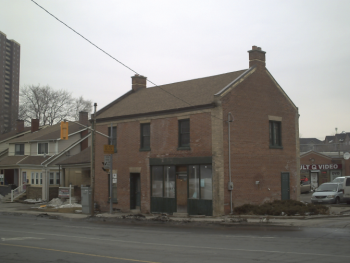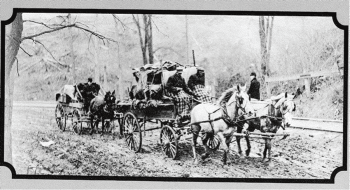
These days, the intersection of Weston Road and Wilson Avenue is located at the southerly portion of Emery Village’s catchment area. The formation of these crossroads has some very interesting history.
Our link along Weston Road was created by the Huron Indians and dates back 600 years.
Both Weston Road and Wilson Avenue were then configured in 1795 as pioneer dirt roads by the Kings’ Rangers under direction of Lord John Graves Simcoe.
At Wilson Avenue, just west of Weston Road, John Chew began running a saw mill along the Humber River in 1846.
On January 1, 1847, John Chew ran the following notice in the British Colonist:
Lumber For Sale. The subscriber offers for Sale at his Mill, Weston, River Humber, a large quantity of Pine and Oak Lumber of all the different kinds usually cut for the Toronto Market, partly seasoned, and of excellent quality, Cheap For Cash. Signed John Chew. Weston, Dec 21, 1846

When it rained, the concession roads and sideroads became interlaced with mud and were challenging to pass by wagon along the many hilly sections of Weston Road. Due to the frustration, a new road was privately conceived of and constructed in 1848 by The Albion Plank-Road Company. Partners in this company were Matthew, Thomas and Joseph Griffith (Weston and Sheppard), John Chew (Weston and Wilson) and John Grubbe (Thistletown).
The head office still stands today on the east side of Weston Road at St. Phillips Road. The men devised a plan to build an alternative and superior roadway and bridge and name it, Albion Road. They wanted to create a roadway that would be more passable and less prone for wagons getting stuck in the mud. They built the new road using planks of wood from John Chew’s saw mill and finally set up their own toll booth at the corner of Wilson Avenue and Weston Road. Starting in 1860, fees were collected at the toll booth for the upkeep of the road.
However, the toll road was no more pleasing than the other plank roads built around the same time, since horses hooves wore the planks out. The toll booth was strategically placed at a very busy intersection leading north up to Emery (Main Street) or north-west to Thistletown along Albion. The actual starting point of Albion Road was initially the intersection of Weston Road across newly built Flindon Bridge.
 As the neighbouring community expanded after WWII, there became a need to improve local public transit. The closest TTC trolley car stop at the time (electrified buses)only ran as far north as Weston Road at Oak Street, about a kilometre south of Wilson.
As the neighbouring community expanded after WWII, there became a need to improve local public transit. The closest TTC trolley car stop at the time (electrified buses)only ran as far north as Weston Road at Oak Street, about a kilometre south of Wilson.
During the mid to late 50s, the TTC decided to extend trolley-car service north and opened an open air transit brickshelter located on the east side of Weston Road close to newly built Blondin Avenue. The TTC stop became known as The Blondin Loop because north-bound trolley-cars did a loop-the-loop and headed back south toward the Town of Weston. The Blondin Loop station was built of sturdy brick with plenty of windows and plenty of fixed seating inside. It had the feel of a real bus terminal and was ironically built on the precise spot of the original pioneer toll booth.
The only remnants of former Blondin Avenue are street lights and fire hydrants still intact and standing in the open field. There is also some weedy remnants along a dedicated right-of-way walking path used by children to walk to Melody Road Public School.
The Blondin Loop and connecting plaza and nearby homes have been levelled for some time now.
 Today, the land where the Blondin Loop, the accompanying plaza, the homes on the south side of Walsh Avenue and all of the former homes on Blondin Avenue are owned by the Sorbara Group and await development. We made every attempt to contact the Sorbara Group for comments but were unable to receive any updated information on the future plans for the development.
Today, the land where the Blondin Loop, the accompanying plaza, the homes on the south side of Walsh Avenue and all of the former homes on Blondin Avenue are owned by the Sorbara Group and await development. We made every attempt to contact the Sorbara Group for comments but were unable to receive any updated information on the future plans for the development.














